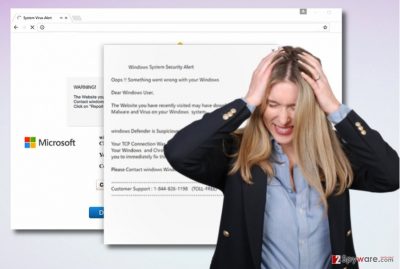“Windows System Security Alert” Tech Support Scam virus (Virus Removal Instructions) - Microsoft Support Scam
“Windows System Security Alert” Tech Support Scam virus Removal Guide
What is “Windows System Security Alert” Tech Support Scam virus?
Why do my browser keeps showing “Windows System Security Alert” warnings?
“Windows System Security Alert” virus is a malicious[1] computer program that falsely informs the victim about non-existent problems on the system. Such viruses aim to scare the victim and convince him/her call tech support scammers[2] via a provided phone number. “Windows System Security Alert” tech support scam alerts typically show up via user’s web browser. The virus opens a web browser and loads a phishing[3] website that is full of bogus Microsoft logos and warnings. For example, such phishing pages claim that the user recently visited a website that contained malware and now the computer system is infected. Therefore, the victim “needs to contact Windows Help Desk For Immediate Support and resolve this issue at Toll-Free 1-844-826-1196.”

How do such programs occupy computer systems?
If “Windows System Security Alert” pop-ups show up repeatedly, it means that a certain program is responsible for sending them to you. You have to find the source of these alerts and uninstall it; however, you should also educate yourself and learn how such malicious programs hijack the computer system. There are numerous ways of how “Windows System Security Alert” can get into your PC system. It can be downloaded by a Trojan that you installed in the past, it can be sent to you via email or installed alongside another program that it is bundled with. To protect your PC from unwanted programs, you should prepare a proper anti-malware defense plan, and you for sure need an anti-malware software. It is not the traditional antivirus program – it can protect your PC from a wide range of malicious programs. You should never open questionable email letters or install free programs carelessly – it is the easiest way to “invite” suspicious files to your PC.
How can I remove “Windows System Security Alert” malware?
If you are looking for the easiest way to remove “Windows System Security Alert” virus, use an automatic virus/malware removal tool. We do not provide manual removal instructions since this virus tends to hide itself under a variety of different names, so it can be hard to find it on the system. To detect the program that attempts to trick you into calling tech support scammers, run a system scan with a powerful anti-malware software. Begin the “Windows System Security Alert” removal procedure by using instructions that we prepared for you.
Getting rid of “Windows System Security Alert” Tech Support Scam virus. Follow these steps
Manual removal using Safe Mode
Restart your PC using instructions. Then start your antivirus/anti-malware/anti-spyware program and let it scan the system thoroughly. Give it a good 20 minutes (or as much as it takes to finish the scan). Delete detected files and programs. Restart your PC again and see if you can still see “Windows System Security Alert” pop-ups while browsing the Internet.
Important! →
Manual removal guide might be too complicated for regular computer users. It requires advanced IT knowledge to be performed correctly (if vital system files are removed or damaged, it might result in full Windows compromise), and it also might take hours to complete. Therefore, we highly advise using the automatic method provided above instead.
Step 1. Access Safe Mode with Networking
Manual malware removal should be best performed in the Safe Mode environment.
Windows 7 / Vista / XP
- Click Start > Shutdown > Restart > OK.
- When your computer becomes active, start pressing F8 button (if that does not work, try F2, F12, Del, etc. – it all depends on your motherboard model) multiple times until you see the Advanced Boot Options window.
- Select Safe Mode with Networking from the list.

Windows 10 / Windows 8
- Right-click on Start button and select Settings.

- Scroll down to pick Update & Security.

- On the left side of the window, pick Recovery.
- Now scroll down to find Advanced Startup section.
- Click Restart now.

- Select Troubleshoot.

- Go to Advanced options.

- Select Startup Settings.

- Press Restart.
- Now press 5 or click 5) Enable Safe Mode with Networking.

Step 2. Shut down suspicious processes
Windows Task Manager is a useful tool that shows all the processes running in the background. If malware is running a process, you need to shut it down:
- Press Ctrl + Shift + Esc on your keyboard to open Windows Task Manager.
- Click on More details.

- Scroll down to Background processes section, and look for anything suspicious.
- Right-click and select Open file location.

- Go back to the process, right-click and pick End Task.

- Delete the contents of the malicious folder.
Step 3. Check program Startup
- Press Ctrl + Shift + Esc on your keyboard to open Windows Task Manager.
- Go to Startup tab.
- Right-click on the suspicious program and pick Disable.

Step 4. Delete virus files
Malware-related files can be found in various places within your computer. Here are instructions that could help you find them:
- Type in Disk Cleanup in Windows search and press Enter.

- Select the drive you want to clean (C: is your main drive by default and is likely to be the one that has malicious files in).
- Scroll through the Files to delete list and select the following:
Temporary Internet Files
Downloads
Recycle Bin
Temporary files - Pick Clean up system files.

- You can also look for other malicious files hidden in the following folders (type these entries in Windows Search and press Enter):
%AppData%
%LocalAppData%
%ProgramData%
%WinDir%
After you are finished, reboot the PC in normal mode.
Remove “Windows System Security Alert” Tech Support Scam using System Restore
-
Step 1: Reboot your computer to Safe Mode with Command Prompt
Windows 7 / Vista / XP- Click Start → Shutdown → Restart → OK.
- When your computer becomes active, start pressing F8 multiple times until you see the Advanced Boot Options window.
-
Select Command Prompt from the list

Windows 10 / Windows 8- Press the Power button at the Windows login screen. Now press and hold Shift, which is on your keyboard, and click Restart..
- Now select Troubleshoot → Advanced options → Startup Settings and finally press Restart.
-
Once your computer becomes active, select Enable Safe Mode with Command Prompt in Startup Settings window.

-
Step 2: Restore your system files and settings
-
Once the Command Prompt window shows up, enter cd restore and click Enter.

-
Now type rstrui.exe and press Enter again..

-
When a new window shows up, click Next and select your restore point that is prior the infiltration of “Windows System Security Alert” Tech Support Scam. After doing that, click Next.


-
Now click Yes to start system restore.

-
Once the Command Prompt window shows up, enter cd restore and click Enter.
Finally, you should always think about the protection of crypto-ransomwares. In order to protect your computer from “Windows System Security Alert” Tech Support Scam and other ransomwares, use a reputable anti-spyware, such as FortectIntego, SpyHunter 5Combo Cleaner or Malwarebytes
How to prevent from getting malware
Stream videos without limitations, no matter where you are
There are multiple parties that could find out almost anything about you by checking your online activity. While this is highly unlikely, advertisers and tech companies are constantly tracking you online. The first step to privacy should be a secure browser that focuses on tracker reduction to a minimum.
Even if you employ a secure browser, you will not be able to access websites that are restricted due to local government laws or other reasons. In other words, you may not be able to stream Disney+ or US-based Netflix in some countries. To bypass these restrictions, you can employ a powerful Private Internet Access VPN, which provides dedicated servers for torrenting and streaming, not slowing you down in the process.
Data backups are important – recover your lost files
Ransomware is one of the biggest threats to personal data. Once it is executed on a machine, it launches a sophisticated encryption algorithm that locks all your files, although it does not destroy them. The most common misconception is that anti-malware software can return files to their previous states. This is not true, however, and data remains locked after the malicious payload is deleted.
While regular data backups are the only secure method to recover your files after a ransomware attack, tools such as Data Recovery Pro can also be effective and restore at least some of your lost data.
- ^ Malicious Software - Definition . Kaspersky Internet Security Center. Cyber Security Resource for Tips, Topics and Trends.
- ^ Liam Tung. Microsoft: Beware this fake Windows BSOD from tech support scammers' malware. ZDNet. Technology News, Analysis, Comments and Product Reviews.
- ^ How to recognize phishing email messages, links, or phone calls. Microsoft Safety and Security Center.
- ^ Tech Support Scams – Help . Official Malwarebytes Security Blog.
- ^ How to identify and avoid scareware. Norton. Articles About Cybersecurity.





















